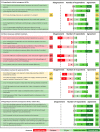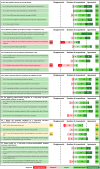Management of superficial and deep surgical site infection: an international multidisciplinary consensus
- PMID: 33770411
- PMCID: PMC8397635
- DOI: 10.1007/s13304-021-01029-z
Management of superficial and deep surgical site infection: an international multidisciplinary consensus
Abstract
Surgical site infections represent a considerable burden for healthcare systems. To obtain a consensus on the impact and future clinical and economic needs regarding SSI management in an era of multidrug resistance. A modified Delphi method was used to obtain consensus among experts from five European countries. The Delphi questionnaire was assembled by a steering committee, verified by a panel of experts and administered to 90 experts in 8 different surgical specialities (Abdominal, Cancer, Cardiac, General surgery, Orthopaedic, Thoracic, Transplant and Vascular and three other specialities (infectious disease, internal medicine microbiology). Respondents (n = 52) reached consensus on 62/73 items including that resistant pathogens are an increasing matter of concern and increase both treatment complexity and the length of hospital stay. There was strong positive consensus on the cost-effectiveness of early discharge (ED) programs, improvement of quality of life with ED and association between increased length of stay and economic burden to the hospital. However, established ED protocols were not widely available in their hospitals. Respondents expressed a positive consensus on the usefulness of antibiotics that allow ED. Surgeons are aware of their responsibility in an interdisciplinary team for the treatment of SSI, and of the impact of multidrug-resistant bacteria in the context of SSI. Reducing the length of hospital stays by applying ED protocols and implementing new treatment alternatives is crucial to reduce harm to patients and costs for the hospital.
Keywords: Antimicrobial; Management; Surgical site infection.
© 2021. The Author(s).
Conflict of interest statement
Gabriele Sganga, Mohamed Baguneid, Pascal Dohmen, Emilio Romanini and Athanassios Vozikis declare no conflicts of interest. E.J. Giamarellos-Bourboulis has received honoraria from AbbVie USA, Abbott CH, Biotest Germany, Brahms GmbH, InflaRx GmbH, MSD Greece, XBiotech Inc. and Angelini Italy; independent educational grants from AbbVie, Abbott, Astellas Pharma Europe, AxisShield, bioMérieux Inc, InflaRx GmbH, the Medicines Company and XBiotech Inc.; and funding from the FrameWork 7 program HemoSpec (granted to the National and Kapodistrian University of Athens), the Horizon2020 Marie-Curie Project European Sepsis Academy (granted to the National and Kapodistrian University of Athens), and the Horizon 2020 European Grant ImmunoSep (granted to the Hellenic Institute for the Study of Sepsis). Christian Eckmann received honoraria for lectures and advisory boards from Angelini, Correvio, Nabriva, Merck and Pfizer.
Figures




Similar articles
-
Risk Assessment of Abdominal Wall Thickness Measured on Pre-Operative Computerized Tomography for Incisional Surgical Site Infection after Abdominal Surgery.J Med Assoc Thai. 2015 Jul;98(7):677-83. J Med Assoc Thai. 2015. PMID: 26267990
-
Healthcare-Associated Infections Due to Multidrug-Resistant Organisms: a Surveillance Study on Extra Hospital Stay and Direct Costs.Curr Pharm Biotechnol. 2019;20(8):643-652. doi: 10.2174/1389201020666190408095811. Curr Pharm Biotechnol. 2019. PMID: 30961489
-
Reducing adult cardiac surgical site infections and the economic impact of using multidisciplinary collaboration.J Hosp Infect. 2018 Dec;100(4):428-436. doi: 10.1016/j.jhin.2018.03.028. Epub 2018 Mar 28. J Hosp Infect. 2018. PMID: 29604297
-
The economic benefits of surgical site infection prevention in adults: a systematic review.J Hosp Infect. 2020 Sep;106(1):76-101. doi: 10.1016/j.jhin.2020.05.011. Epub 2020 May 15. J Hosp Infect. 2020. PMID: 32417433
-
Using a modified Delphi methodology to gain consensus on the use of dressings in chronic wounds management.J Wound Care. 2018 Mar 2;27(3):156-165. doi: 10.12968/jowc.2018.27.3.156. J Wound Care. 2018. PMID: 29509111
Cited by
-
Pharmacokinetic Interpretation of Applying Local Drug Delivery System for the Treatment of Deep Surgical Site Infection in the Spine.Pharmaceutics. 2024 Jan 10;16(1):94. doi: 10.3390/pharmaceutics16010094. Pharmaceutics. 2024. PMID: 38258104 Free PMC article.
-
Antimicrobial resistance patterns of WHO priority pathogens at general hospital in Southern Ethiopia during the COVID-19 pandemic, with particular reference to ESKAPE-group isolates of surgical site infections.BMC Microbiol. 2025 Feb 22;25(1):84. doi: 10.1186/s12866-025-03783-1. BMC Microbiol. 2025. PMID: 39987036 Free PMC article.
-
Chlorhexidine Wound Irrigation for the Prevention of Early Surgical Site Infection in Orthopaedic Surgeries in Resource-Limited Settings: A Randomized Controlled Trial.Cureus. 2024 Nov 7;16(11):e73235. doi: 10.7759/cureus.73235. eCollection 2024 Nov. Cureus. 2024. PMID: 39650968 Free PMC article.
-
Construction and validation of a nomogram predictive model for assessing the risk of surgical site infections following posterior lumbar fusion surgery.Sci Rep. 2025 Jan 6;15(1):1023. doi: 10.1038/s41598-024-84174-w. Sci Rep. 2025. PMID: 39762306 Free PMC article.
-
Alcoholic vs. aqueous chlorhexidine for abdominal surgery skin preparation: a randomized controlled trial.Sci Rep. 2025 Aug 9;15(1):29228. doi: 10.1038/s41598-025-15379-w. Sci Rep. 2025. PMID: 40783456 Free PMC article. Clinical Trial.
References
-
- Suetens C, Latour K, Kärki T, Ricchizzi E, Kinross P, Moro ML, The Healthcare-Associated Infections Prevalence Study Group et al. Prevalence of healthcare-associated infections, estimated incidence and composite antimicrobial resistance index in acute care hospitals and long-term care facilities: results from two European point prevalence surveys, 2016 to 2017. Euro Surveill. 2018;23:1800516. doi: 10.2807/1560-7917.ES.2018.23.46.1800516. - DOI - PMC - PubMed
-
- Cassini A, Plachouras D, Eckmanns T, Abu Sin M, Blank HP, Ducomble T, et al. Burden of six healthcare-associated infections on european population health: estimating incidence-based disability-adjusted life years through a population prevalence-based modelling study. PLoS Med. 2016;13:e1002150. doi: 10.1371/journal.pmed.1002150. - DOI - PMC - PubMed
MeSH terms
LinkOut - more resources
Full Text Sources
Other Literature Sources

